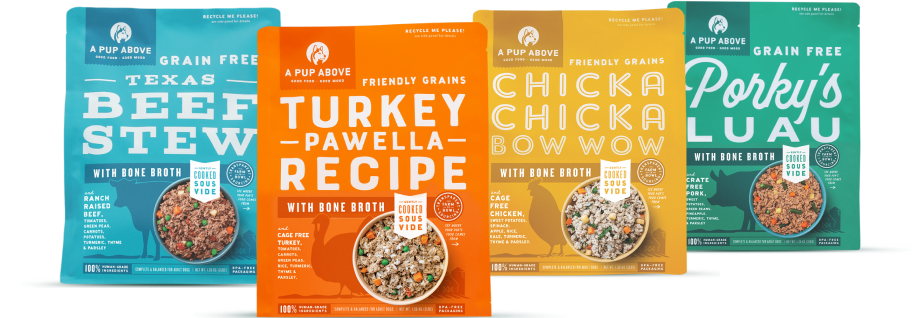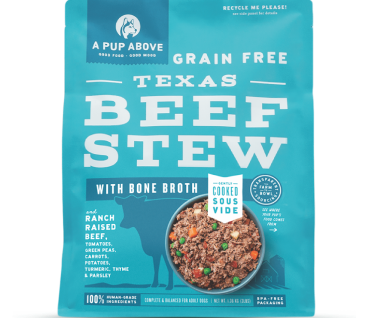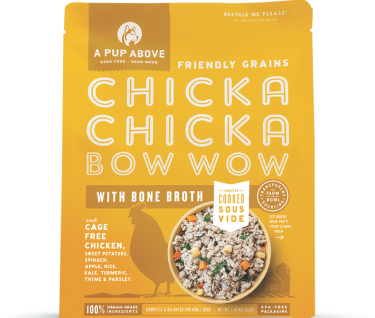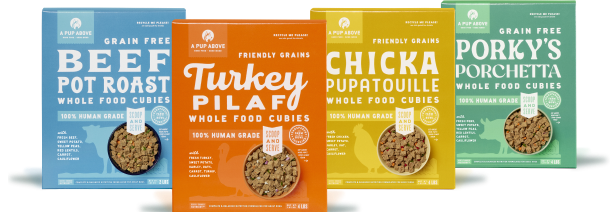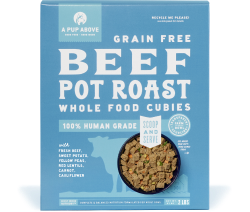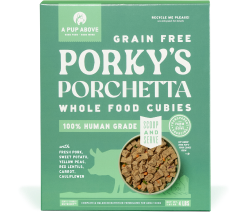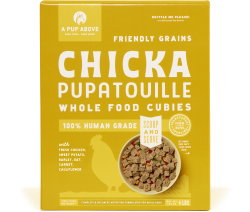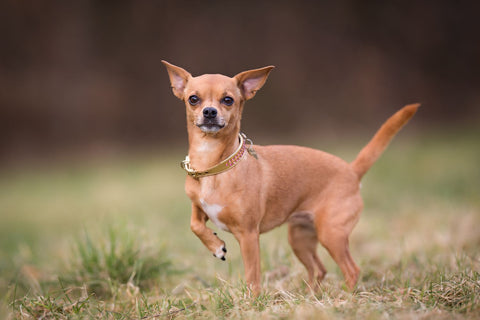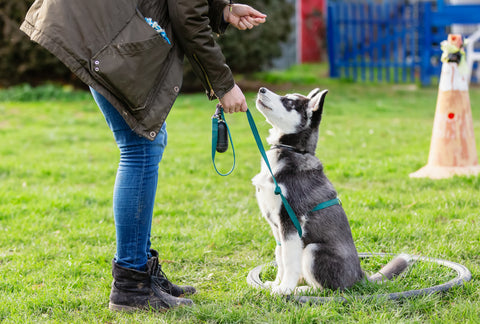
Ever popped open a can of wet dog food and wondered just what goes into that juicy mixture? At A Pup Above, we're all about feeding our dogs the very best, which means understanding all the options out there.
This article dives into the world of wet dog food — what it is, how it’s made, and why it might be a tasty choice for your dog. So, if you’re interested in discovering the savory details of this popular pet food option, sit, stay, and read on!
What Is Wet Dog Food?
Wet dog food, often found in cans or pouches, is exactly what it sounds like: food for dogs that is primarily composed of moisture. Unlike dry kibble, which is cooked and dehydrated, wet food retains much of its water content through the cooking process.
This moisture makes wet dog food soft and easy to eat, which can be appealing to dogs of all ages, from energetic puppies to older dogs with sensitive teeth. Typically, it contains a higher proportion of fresh meat, poultry, fish, and animal byproducts, along with various grains, fruits, and vegetables that provide essential nutrients.
The high moisture content not only helps keep dogs hydrated but also enhances the food’s aroma and flavor, making it a tempting treat for your dog.
Why Do Some Pet Owners Choose Wet Dog Food?
Choosing the right food for your dog involves weighing various factors, including taste, nutrition, and ease of feeding.
Here are several reasons why many pet owners go for wet dog food:
Enhanced Palatability
Wet dog food often has a richer taste and scent compared to dry kibble, making it highly appealing to dogs. This can be particularly beneficial for picky eaters who may be more inclined to dig into a meal that smells and tastes closer to fresh food.
Hydration
With its high moisture content, wet dog food is a great source of hydration, especially important for dogs who aren’t keen on drinking their water throughout the day. This can be crucial for maintaining proper kidney and urinary tract health.
Easier To Chew
The soft texture of wet food makes it an excellent choice for puppies, senior dogs, or any dog with dental issues that make chewing hard, dry food a challenge.
Variety of Flavors and Textures
Wet food comes in a multitude of flavors and textures, including pate, filet, stew, and chunks in gravy, which can be a delightful change for dogs looking for something different than their usual dry food.
Potentially Fewer Fillers
While not always the case, some wet dog foods contain fewer fillers like corn, wheat, and soy compared to their dry counterparts. This can lead to better digestibility and fewer allergic reactions.
Portion Control
Wet dog food cans or pouches can help pet owners conveniently manage feeding portions, ensuring dogs get the right amount of food based on their weight, age, and energy levels.
Is Wet Dog Food Nutritionally Adequate for My Dog?
Wet dog food can be a completely balanced diet for your pup as long as you choose the right product.
Here’s what to consider to ensure it meets your dog’s dietary needs:
Complete Formulation
Look for wet dog foods labeled as "complete and balanced." This means they meet the nutritional levels established by the AAFCO Dog Food Nutrient Profiles for all life stages or for adult maintenance.
Protein Quality
High-quality protein should be a key ingredient. Check the label for real meat like turkey, venison, or chicken as the primary source, which helps support muscle maintenance and overall health.
Added Vitamins and Minerals
Ensure the food includes a variety of vitamins and minerals to support your dog’s health system. Products that include essential components like high protein, sweet potato, or brown rice offer added nutritional benefits.
Special Dietary Needs
Consider your dog’s specific health needs — such as grain-free or gluten-free requirements or formulations for sensitive stomachs or allergies. Wet dog food often comes in recipes that cater to these needs.
Who Should Consider Wet Dog Food?
Wet dog food isn’t just for picky eaters; it can be a practical choice for many dogs, tailored to various needs:
- Senior Dogs: Older dogs with decreased teeth strength or gum issues can find the softer texture of wet food easier to handle.
- Puppies: Young dogs transitioning from milk to solid food may find wet food more appealing and digestible.
- Dogs With Hydration Issues: Dogs that typically ignore their water bowl might benefit from the moisture in wet food, helping to keep them hydrated.
- Dietary Restrictions: Dogs with specific health concerns may find wet food options available that support their dietary needs, like low-fat for pancreatitis or low-sodium for heart conditions.
Wet dog food can offer a flavorful, hydrating, and satisfying meal, making it a worthy consideration for any dog owner.
How Do I Integrate Wet Dog Food Into My Dog’s Diet?
Switching to or incorporating wet dog food into your dog’s diet should be done gradually to avoid digestive upset.
Here’s how to make the transition smoother:
Begin Slowly
Ease your dog into wet food by mixing it with their current dry dog food. This can help them adjust without upsetting their stomach.
Variety Is the Spice of Life
Use a variety pack to introduce different flavors and textures, such as chicken liver, chicken pate, or even a venison entree, which can cater to the unique preferences of both small and large breeds.
Specific Needs
Choose options that suit your dog's specific stages of life and wellness requirements — puppy food for the young ones or a diet formulated for senior dogs to address their age-specific nutritional needs.
Balance the Diet
If you’re not feeding a 100% wet food diet, ensure the rest of your dog’s meals are nutritionally balanced. Consider adding high-quality, fresh, human-grade food like our Turkey Pawella or Porky’s Luau to provide a mix of textures and nutrients.
Our sous-vide method retains natural flavors and nutrients, making it a delicious and healthy choice that complements any wet food regimen.
Monitor and Adjust
Keep an eye on how your dog reacts to the new diet. Look for signs of improved energy and digestion, and adjust portions or types as necessary to meet your dog’s needs.
Storage and Safety
Keep canned dog food refrigerated after opening and use it within the recommended time to ensure freshness and prevent spoilage.
Consult Your Vet
Always consult with your veterinarian before making significant changes to your dog's diet, especially if they have health conditions like a sensitive stomach or specific dietary restrictions.
Conclusion
Wet dog food offers a tasty, hydrating, and nutrient-rich meal option that can cater to a variety of canine needs. Whether you're nurturing a small breed puppy or caring for a large breed senior, the right wet food can enhance your dog's wellness and satisfy their nutritional needs at every life stage.
At A Pup Above, while we specialize in crafting fresh, sous-vide human-grade meals, we appreciate the role that high-quality wet dog food can play in a balanced diet. Remember, the best wet dog food is the one that meets your dog’s specific needs, ensuring they're not just well-fed but thriving.
Sources:
Dry, Canned, or Semi-Moist: Food Choices for Dogs | VCA
“Complete and Balanced” Pet Food | FDA

